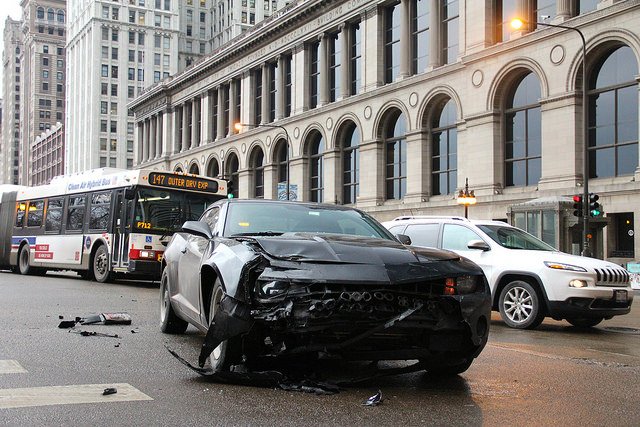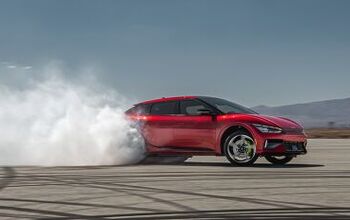Automatic Emergency Braking Won't Always Stop a Crash, But Americans Think It Will

Automatic emergency braking is finding its way into more and more cars (and automakers have a pact to make it standard equipment by 2022), but most drivers don’t know the technology’s limitations.
AEB systems slow or stop a vehicle in an emergency, preventing or mitigating a crash, but an American Automobile Association study shows that 71 percent of U.S. drivers familiar with the technology believe AEB will prevent all crashes.
AAA partnered with the Automobile Club of Southern California’s Automotive Research Center to test five 2016 models equipped with AEB. The tests showed the systems worked more or less as planned. During 70 trials, vehicles with AEB designed to prevent crashes slowed by twice the amount as those designed to simply slow the vehicle before impact.
Vehicles designed to prevent crashes shed, on average, 79 percent of their speed before impact. Those designed to mitigate the crash slowed by 40 percent. In tests conducted at speeds of 30 miles per hour or less, crash-avoiding AEB systems prevented 60 percent of the planned collisions
Still, there were some surprises in store for researchers. Under 30 mph, the systems designed to only lessen the impact actually avoided a collision 33 percent of the time.
At higher speeds, the performance of both systems diminished. At 45 mph, the crash-avoidance systems slowed the test vehicle by 74 percent, on average, and prevented collisions 40 percent of the time. The lesser AEB system only reduced vehicle speeds by nine percent.
Obviously, any reduction in speed helps the vehicle’s occupants. A speed reduction from 30 to 20 mph cuts the energy of an impact by 50 percent.
Still, the majority of drivers believe that all AEB systems will prevent a crash, without the need to manually apply the brakes. There’s a risk that motorists in AEB-equipped vehicles will become overconfident in their vehicle’s abilities. Slowing to 36 mph before hitting another vehicle is a far different outcome that avoiding the other car completely.
“The reality is that today’s systems vary greatly in performance, and many are not designed to stop a moving car,” said John Nielsen, AAA’s managing director of Automotive Engineering and Repair, in a statement.
Currently, nine percent of Americans drive a vehicle equipped with AEB. By September, 2022, virtually every new light-duty truck and car will carry the technology as standard equipment.
[Image: Daniel X. O’Neil/ Flickr]

More by Steph Willems
Latest Car Reviews
Read moreLatest Product Reviews
Read moreRecent Comments
- Tane94 Mini annual oil change at dealership, synthetic oil and new filter, $129 but sometimes $99 when a coupon is offered.
- Mike Beranek All that chrome on the dashboard must reflect the sun something fierce. There is so much, and with so many curves, that you would always have glare from somewhere. Quite a contrast to those all-black darkroom interiors from Yurp.
- Mike Beranek 2004 Buick LeSabrepurchased in 2017, 104k, $3,100currently 287knever been jumped never been on a tow truckstruts & shocks, wheel bearings, EGR valves. A couple of O2 sensors, an oil pressure sending unit, and of course the dreaded "coolant elbows". All done in my garage with parts so plentiful there are a dozen choices of everything on Rock Auto.I've taken it to the west coast twice and the east coast once. All-in I'm under 5 grand for over 180,000 reliable miles. Best used-car purchase ever.
- Jalop1991 Our MaintenanceCosts has been a smug know-it-all.
- MaintenanceCosts If I were shopping in this segment it would be for one of two reasons, each of which would drive a specific answer.Door 1: I all of a sudden have both a megacommute and a big salary cut and need to absolutely minimize TCO. Answer: base Corolla Hybrid. (Although in this scenario the cheapest thing would probably be to keep our already-paid-for Bolt and somehow live with one car.)Door 2: I need to use my toy car to commute, because we move somewhere where I can't do it on the bike, and don't want to rely on an old BMW every morning or pay the ensuing maintenance costs™. Answer: Civic Si. (Although if this scenario really happened to me it would probably be an up-trimmed Civic Si, aka a base manual Acura Integra.)


































Comments
Join the conversation
Breaking news: Human stupidity threatens ability to maintain oxygen inhalation. Film at 11.
"Still, the majority of drivers believe that all AEB systems will prevent a crash, without the need to manually apply the brakes." Yeah, people are stupid. And they rely on and trust technology too much - implicitly and instantaneously. They assume because they have a feature, their guard and common sense can be disabled. See: Tesla Autopilot See: GPS crashes See: AWD overconfidence See: ABS overconfidence See: Backup cameras